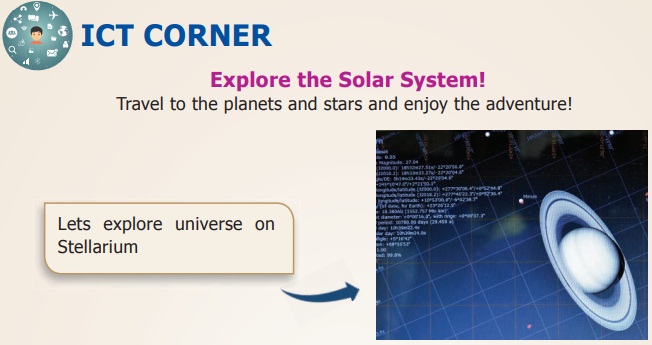The Universe and Solar System | Term 1 Unit 1 | Geography | 6th Social Science - Wrap Up, Glossary | 6th Social Science : Geography : Term 1 Unit 1 : The Universe and Solar System
Chapter: 6th Social Science : Geography : Term 1 Unit 1 : The Universe and Solar System
Wrap Up, Glossary
Wrap Up
* The Universe was formed 15 billion years after the Big Bang explosion
* Many galaxies are found in the Universe.
* Our solar system is a part of the Milky Way Galaxy.
* The Sun is so huge that it accounts for 99.8 percent of the entire mass of the solar system.
* All planets rotate anti-clockwise on their own axes except Venus and Uranus.
* Asteroids are found as a belt between Mars and Jupiter.
* The rotation of the Earth causes day and night.
* The revolution of the Earth causes seasons.
* Summer solstice is the longest day in the Northern Hemisphere.
* The presence of land, water and air along with suitable climate makes life possible on Earth.
GLOSSARY
1. Galaxy - The cluster of stars
2. Asteroids - Irregular shaped rocks between Mars and Jupiter
3. Meteors - Space particles left behind by comets or asteroids
4. Comets - Frozen lumps of rocks, dust and gas.
5. Satellites - Celestial bodies that move around the planets.
6. Orbit - The path in which the planets move around the Sun.
7. Earth's axis - An imaginary line passing through the centre of the Earth from the North Pole to the South Pole.
8. Rotation - Spinning movement of the planets on their axes.
9. Revolution - The movement of the planets around the Sun in their orbit.
10. Equinox - The day on which day and night are of equal length.
11. Solstice - An occurrence when the Tropic of Cancer and Tropic of Capricorn faces the Sun vertically.
12. Rover - A space exploration vehicle which moves across the surface of a celestial body
13. Orbiter - A spacecraft which orbits a celestial body without landing on its surface.
References
1. John
Widdowson (1999), Earthworks 2, 11-14 Geography Project, Hodder Education
2. James
F. Petersen, Dorothy Sack, Robert E. Gabler, (2011), Fundamentals of Physical Geography,
Brooks/Cole, Cengage Learning
3. H.J.Blij,
Peter O Muller, Richard S. Williams, Jr., Physical Geography - The Global Environment,
III Edition, Oxford University Press
Internet Resources
1. www.nationalgeographic.org/ encylopedia/seasons
2. www.slideshare.net
4. www.geography4kids.com
5. https://sangamtamilliterature.
wordpress.com/thd_,ay;
ICT CORNER
Explore
the Solar System!
Travel to the planets
and stars and enjoy the adventure!

Lets explore universe on Stellarium
Step 1:
Download and install
the ‘Stellarium’ app from the given link. Double click and open the “Stellarium”
app
Step 2:
Click the “Location
window” or F6. Then select your location using drop down boxes and view the placements
of celestial bodies in the sky.
Step 3:
Click the “Date/Time
window” or F5. Then set the date and time zone of your location.
Step 4:
Use the “Search window”
or F3 and type any name of the solar system to explore them.Select and zoom in on
the Earth and play with increase or decrease speed buttons to view its rotation.

URL to download Stellarium app:
Related Topics